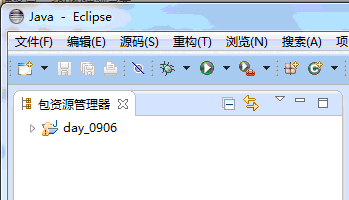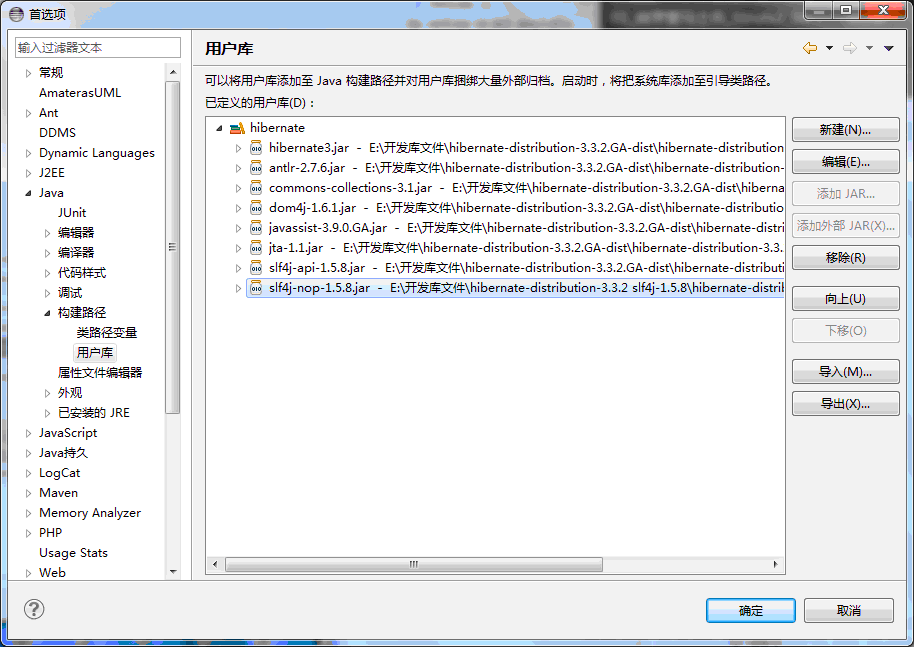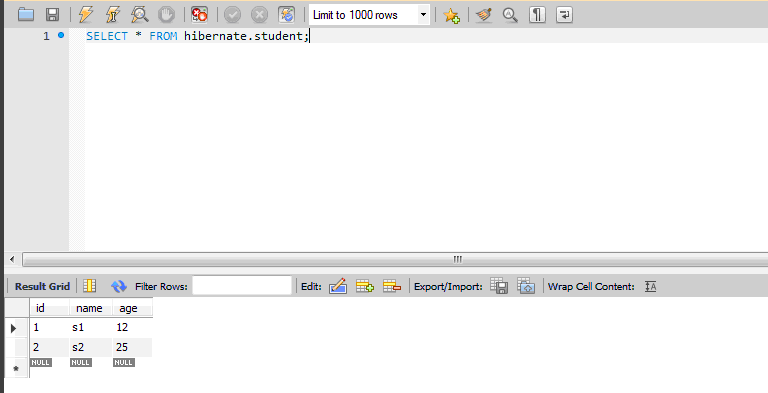Hibernate系列之基本配置
一、概述
Hibernate是一个开放源码的对象关系映射框架,它对JDBC进行了非常轻量级的对象封装,使我们可以使用对象的编程思维来操作数据库。
二、配置准备
IDE:Eclipse
下载Jar包:

三、配置步骤
1、创建新的Java项目

2、建立用户库-hibernate,引入相应的jar包
- 项目右键-build path->configue build path->add library
- 选择user library,在其中新建library,命名为Hibernate
- 在该library中加入Hibernate所需要的jar包

3、引入mysql的驱动包
4、在mysql中建立相应的数据库以及表

5、建立Hibernate配置文件hibernate.cfg.xml
这部分可以从参考文档中拷贝,然后修改对应的数据库连接。eg:
<?xml version='1.0' encoding='utf-8'?> <!DOCTYPE hibernate-configuration PUBLIC "-//Hibernate/Hibernate Configuration DTD 3.0//EN" "http://hibernate.sourceforge.net/hibernate-configuration-3.0.dtd"> <hibernate-configuration> <session-factory> <!-- Database connection settings --> <property name="connection.driver_class">com.mysql.jdbc.Driver</property> <property name="connection.url">jdbc:mysql://localhost/hibernate</property> <property name="connection.username">root</property> <property name="connection.password">281889</property> <!-- JDBC connection pool (use the built-in) --> <!-- <property name="connection.pool_size">1</property> --> <!-- SQL dialect --> <property name="dialect">org.hibernate.dialect.MySQLDialect</property> <!-- Enable Hibernate's automatic session context management --> <!-- <property name="current_session_context_class">thread</property> --> <!-- Disable the second-level cache --> <property name="cache.provider_class">org.hibernate.cache.NoCacheProvider</property> <!-- Echo all executed SQL to stdout --> <property name="show_sql">true</property> <!-- Drop and re-create the database schema on startup --> <!-- <property name="hbm2ddl.auto">update</property> --> <mapping resource="com/test/demo/Student.hbm.xml"/> </session-factory> </hibernate-configuration>
6、建立一个类
这个类表示我们想要存储在数据库的事件。 这个类使用JavaBean标准命getter和setter方法以及字段。 虽然这是推荐的设计,但它不是必需的。 Hibernate也可以直接访问字段,访问器方法的好处是重构的鲁棒性。 eg:
package com.test.demo; public class Student { private int id; private String name; private int age; public int getId() { return id; } public void setId(int id) { this.id = id; } public String getName() { return name; } public void setName(String name) { this.name = name; } public int getAge() { return age; } public void setAge(int age) { this.age = age; } }
7、建立Student的映射文件Student.hbm.xml
Hibernate需要知道怎样去加载和存储持久化类的对象。这正是Hibernate映射文件发挥作用的地方。映射文件告诉Hibernate它,应该访问数据库(database)里面的哪个表(table)及应该使用表里面的哪些字段(column)。这部分可以参考文档。
<?xml version="1.0"?> <!DOCTYPE hibernate-mapping PUBLIC "-//Hibernate/Hibernate Mapping DTD 3.0//EN" "http://hibernate.sourceforge.net/hibernate-mapping-3.0.dtd"> <hibernate-mapping package="com.test.demo"> <class name="Student"> <id name="id"></id> <property name="name"></property> <property name="age"></property> </class> </hibernate-mapping>
8、将映射文件加入到Hibernate.cfg.xml文件中,参考文档
<mapping resource="com/test/demo/Student.hbm.xml"/>
9、写测试类StudentTest,对student对象进行直接的存储测试
import org.hibernate.Session; import org.hibernate.SessionFactory; import org.hibernate.cfg.Configuration; public class StudentTest { public static void main(String[] args) { Student s = new Student(); s.setId(2); s.setName("s2"); s.setAge(25); Configuration cfg=new Configuration(); SessionFactory sf=cfg.configure().buildSessionFactory(); Session session=sf.openSession(); session.beginTransaction(); session.save(s); //提交事物 session.getTransaction().commit(); session.close(); sf.close(); } }
执行上述测试程序,结果如下:

四、注释版本的配置步骤
1、创建Teacher表,并创建相应字段

2、在hibernate lib中加入annotation的jar包

3、创建Teacher类,并参考文档生成相应的注解
import javax.persistence.Entity; import javax.persistence.Id; @Entity public class Teacher { private int id; private String name; private String title; @Id public int getId() { return id; } public void setId(int id) { this.id = id; } public String getName() { return name; } public void setName(String name) { this.name = name; } public String getTitle() { return title; } public void setTitle(String title) { this.title = title; } }
4、在hibernate.cfg.xml文档中建立映射
<mapping class="com.test.demo.Teacher"/>
5、写测试类TeacherTest,对Teacher对象进行存储测试
import org.hibernate.Session; import org.hibernate.SessionFactory; import org.hibernate.cfg.AnnotationConfiguration; import org.hibernate.cfg.Configuration; public class TeacherTest { public static void main(String[] args) { Teacher t=new Teacher(); t.setId(2); t.setName("t2"); t.setTitle("初级"); Configuration cfg=new AnnotationConfiguration(); SessionFactory sf=cfg.configure().buildSessionFactory(); Session session=sf.openSession(); session.beginTransaction(); session.save(t); //提交事物 session.getTransaction().commit(); session.close(); sf.close(); } }
运行上述程序,结果为:

正文到此结束
热门推荐
相关文章
Loading...











![[HBLOG]公众号](https://www.liuhaihua.cn/img/qrcode_gzh.jpg)

